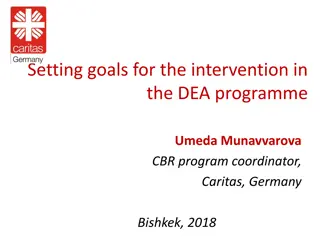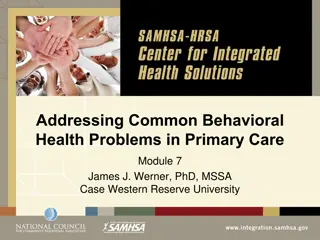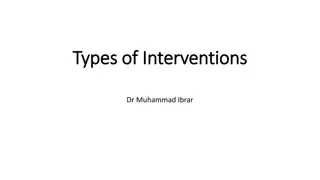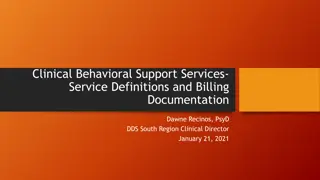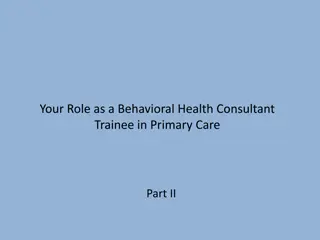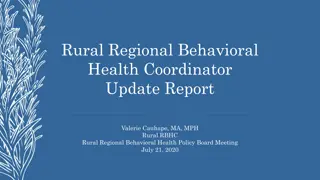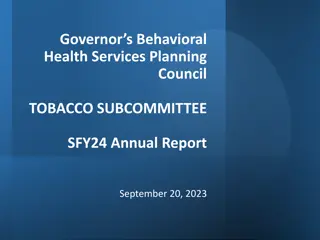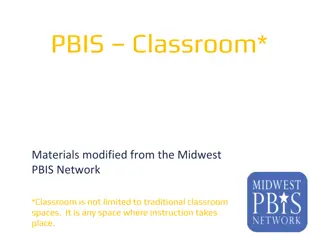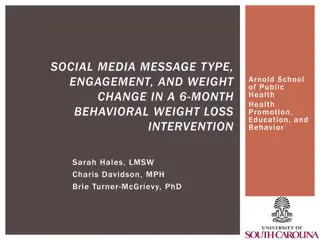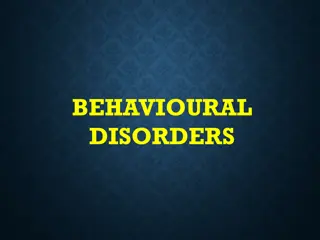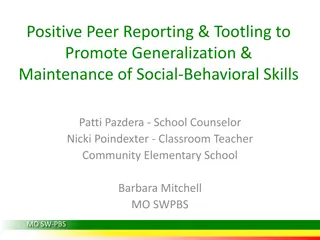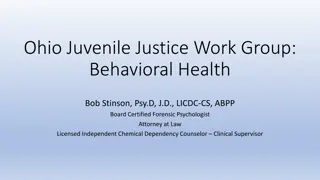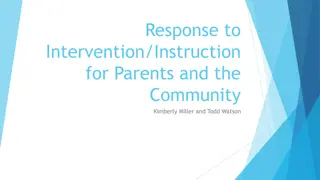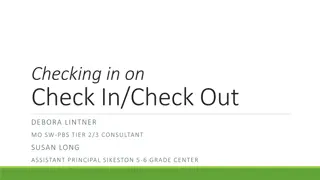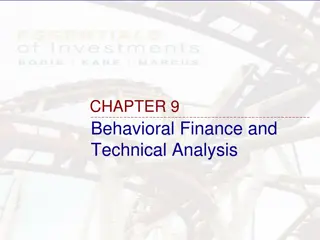Implementing Effective Behavioral Intervention Strategies
Utilize specific methods to identify and define target behaviors, consider ethical considerations and relevant factors, conduct screening and assessments, utilize various measures for data collection, develop detailed behavioral descriptions, and consider tools like Child Behavior Checklist and Adaptive Behavior Scale for effective interventions.
Download Presentation

Please find below an Image/Link to download the presentation.
The content on the website is provided AS IS for your information and personal use only. It may not be sold, licensed, or shared on other websites without obtaining consent from the author. Download presentation by click this link. If you encounter any issues during the download, it is possible that the publisher has removed the file from their server.
E N D
Presentation Transcript
Is extremely important Need to use specific methods to identify and define target behavior Also need to identify relevant factors that may inform or influence intervention
Ethical considerations Authority Permission Resources Social validity
Screening / Assessment 1. 2. Defining problem or criteria for achievement 3. Pinpointing target behaviors 4. Monitoring progress 5. Following-up
1. Indirect measures Interviews Checklists 2. Direct measures Tests Direct Observation 3. Environmental Issues
May need to identify list of potential target behaviors What and when Avoid why What is/are the primary concern(s)
Issues are verified through data collection Direct observation Use of questionnaires Self-monitoring
Develop behavioral descriptions What, when, how Avoid why Move from general to specific Determine participation
Provide descriptions of specific behaviors and conditions under which each should occur Can be done alone or with an interview Often are very specific Typically use Likert-scale assessments Some ask about antecedents and consequences
Child Behavior Checklist Adaptive Behavior Scale -School Adaptive Behavior Scale -Residential and Community
Issues with standardized tests Need consistent administration Compares performance to specified criteria Norm-referenced Limitations Do not specify target behaviors Do not provide direct measure of behavior Licensing requirements
Direct and repeated Natural environment Identifies potential target behaviors Preferred method
Descriptive Temporally sequenced Description of behavior patterns Full attention, 20 -30 min Observations only, no interpretations Repeat over several days Can use a variety of techniques Time Sampling, etc.
Is the data on individual and environment Physical features Interactions with others Home Reinforcement history Evaluate amount of descriptive data required to address current need
Is the effects of assessment on behavior being assessed Obtrusive assessment has a great impact Self-monitoring most obtrusive Reduce reactivity Unobtrusive methods Repeat observations Take effects into account Often need two to three weeks for self - monitoring
Role and Importance of Definitions Definitions required for replication Replication required to determine usefulness of data in other situations Necessary for research
Accurate, on-going evaluation requires explicit definition of behavior Operational definition Complete information Accurate and believable evaluation of effectiveness
Function-based Designated according to effect on the environment Topography-based Identifies the shape or form of the behavior
Includes all members of response class The function of behavior is most important feature Simpler and more concise definitions Easier to measure accurately and reliably
When natural outcome is not within control of behavior analyst Logistical, ethical, or safety reasons E.g., Function of elopement is a lost child In these cases, function-based definition by proxy More restrictive definition that keeps behavior within control of analyst
Behavior analyst does not have direct, reliable, or easy access to functional outcomes Cannot rely on function of behavior because each occurrence does not produce relevant outcome
When the relevant outcome is sometimes produced by undesirable variations of the response class E.g., A basketball player scores with a sloppy shot from the free throw line Definition should encompass all response forms that produce relevant outcomes
Accurate Complete Concise Inclusions Exclusions
Objective Refer only to the observable Clear Readable and unambiguous Complete Delineate boundaries of definition
Precise and concise description Reliable observation Accurate recording Agreement and replication
Can you count number of occurrences? Should answer Yes Will a stranger know what to look for based on definition alone? Should answer Yes Can you break the target behavior down to smaller, more specific components? Should answer No
Selected because of importance to clients Increase, maintain, generalize desirable behaviors Decrease undesirable behaviors Valued and meaningful behaviors have social validity
Setting criteria as important as defining Range of acceptability Must identify optimum range prior to modifying Must know when to terminate treatment Eliminate disagreements on effectiveness
Assess performance of highly competent people Experimentally manipulate different performance levels to determine optimal results
Threat to health or safety 1. 2. Frequency Opportunities to use new behavior Occurrence of problem 3. Longevity 4. Potential for higher rates of reinforcement
Importance Skill development Independence 6. Reduction of negative attention 7. Reinforcement for significant others Social validity Exercise caution when considering 5.
8. Likelihood of success Research Practitioner s experience Environmental variables Available resources 9. Cost-benefit Costs include client s time and effort
Numerical rating of potential target behaviors May need to increase client, parent, and staff participation Resolve conflict Build consensus Can be difficult
Behaviors # 1 # 2 # 3 Does this behavior pose a danger? 0 1 2 3 4 0 1 2 3 4 0 1 2 3 4 How long-standing is this problem or deficit? 0 1 2 3 4 0 1 2 3 4 0 1 2 3 4 Will changing this behavior produce higher rate of reinforcement? 0 1 2 3 4 0 1 2 3 4 0 1 2 3 4 How likely is success in changing this behavior? 0 1 2 3 4 0 1 2 3 4 0 1 2 3 4
Are you getting the information you want Is it accurate What are problems with the data collection Are their side effects of the data collection Ongoing monitoring is critical to ABA
Need good definitions and techniques to identify target behaviors Accuracy at the written and observation level are critical Must know what is INCLUDED Also must know what is EXCLUDED in the definitions and observations
Consider whose behavior is being assessed and why Is it unacceptable to change behavior primarily for benefit of others? To what extent will proposed change improve the person s life? Both questions relate to ethics and philosophy




